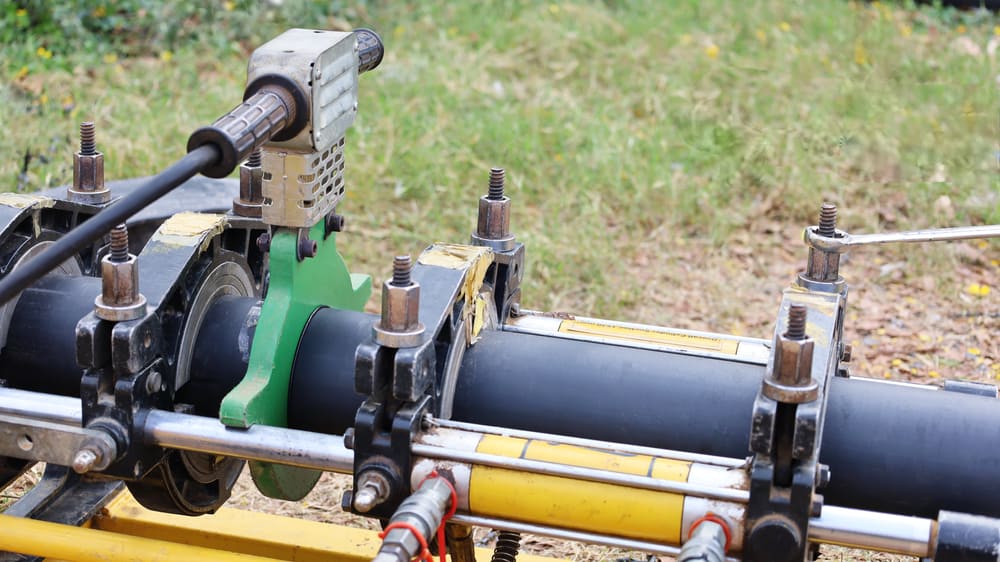Inspecting HDPE Butt Fusion Welds
HDPE, or high-density polyethylene pipe welding, is different from conventional welding than you may imagine. Butt welding of HDPE can be even more different. Butt welding HDPE involves the fusion of flat surfaces utilizing hot plates and is usually used for components such as HDPE pipes or tubes or fittings. However, this welding technique can provide challenges like welding flaws or loss of structural strength. So, inspection to assess the quality of the weld becomes necessary.
While there are many ways to inspect HDPE butt fusion welds, one of the most effective non-destructive testing (NDT) techniques involves using ultrasound technology. However, HDPE material has specific characteristics that can make ultrasonic inspection challenging. It’s therefore critical to implement a robust inspection strategy using multiple ultrasonic testing (UT) techniques to inspect for the flaws present in the weld and does so without affecting the weld strength to ensure the final component being used is of the highest quality.
Butt Fusion Weld Mechanism in HDPE
Butt welding is the most common type of welding process used to join the HDPE pipes. The process involves the joining of two flat surfaces against each other. By flat surface, in HDPE pipes, it means the flat facing surfaces at the two ends of the pipe joined together utilizing high temperature and extreme pressure.
During the heating process, the end of the HDPE pipe is pressed against a heated plate. Once the heated surfaces reach a molten state, the two surfaces are then bought together to join under controlled pressure. Once the molten parts fuse together to form a bond, the cooling process takes place for a specific amount of time, depending upon the dimension and thickness of the pipe. The heating, joining, and cooling processes are critical in ensuring the bond strength and achieving smoothness and quality of the weld.
Throughout each of these butt welding steps, there is also an equal possibility of flaw formation, mostly due to factors like lack of pressure or weld force, inaccurate temperature to achieve desired weld bead, misalignment, inadequate cooling time, improper surface cleaning, or presence of external inclusions in the material. The resulting flaws due to these factors may include:
- “Cold fusion” or partial bond due to inadequate weld force or temperature
- Porosity and cracks resulting from a lack of surface preparation
These flaws need to be thoroughly identified if the HDPE component is used for an application safely. Phased array ultrasonic testing (PAUT) is an ideal inspection solution for HDPE butt fusion.
Effective Inspection of HDPE Butt Fusion Weld
HDPE is an easy-to-use material that also offers excellent strength, corrosion resistivity, flexibility, and durability. This is one of the reasons why HDPE pipes are replacing the conventional carbon steel pipe systems in industries like water supply, oil and gas, geothermal, power generation, and many more. However, for the proper functioning of the operation, these industries need to be sure about the quality of the welds in HDPE pipes and look out for flaws. The different types of flaws including porosity, cracking, inclusion, and lack of bond, can be effectively identified through the application of multiple techniques of PAUT testing.
The attenuative properties of HDPE require inspection with lower frequencies as compared to that of the carbon steel. Therefore, inspection with pulse-echo and tandem PAUT, as well as Time of Flight Diffraction (TOFD) is recommended. PAUT with TOFD offers volumetric inspection ability with high flaw detection sensitivity. The data collected with the help of the PAUT probe enables interpreters to:
- Focus along the heat-affected zones and weld joints to check for any possible flaws.
- Identify the fusion weld bond strength or the lack thereof.
- Locate any inclusions or slags, pores, or voids.
- Minimize the effect of thickness variation or irregularities in the study of flaws with the help of a focused beam enabled by PAUT.
The use of PAUT probes can support accuracy in the inspection of HDPE butt fusion weld and enable fast-paced volumetric inspection which helps industries in quicker decision-making.
| Learn more on the webinar: Ultrasonic Inspection Solution for HDPE Butt Fusion Joints. |
UT Inspection of HDPE Butt Fusion Weld For Quality and Durability
The increasing use of HDPE pipes and fittings means more stringent standards and inspection requirements for the material. PAUT inspection enables accuracy and speed in flaw identification of the HDPE butt fusion weld to allow industries to leverage the excellent properties and advantages of the material to its full extent. In addition, by ensuring the weld’s strength and quality without any interruption, PAUT testing provides cost-effectiveness and productivity for the industrial operation that lasts.
Zetec specializes in ultrasonic testing as well as many other inspection technologies and offers you excellent solutions related to HDPE butt fusion weld inspection needs. To learn more about our quality instruments and probes, contact us today.

Zetec’s designers are industry-leading experts in ultrasonic and eddy current technologies, and we can help you navigate any of our NDT testing solutions or devices.

